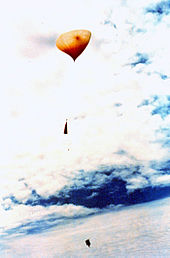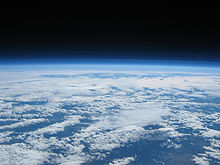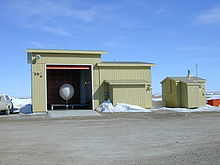- Weather balloon
-
 Rawinsonde weather balloon just after launch. Notice a parachute in the center of the string and a small instrument box at the end. After release it measures many parameters. These include temperature, relative humidity, pressure, and wind speed and wind direction. This information is transmitted back to surface observers.
Rawinsonde weather balloon just after launch. Notice a parachute in the center of the string and a small instrument box at the end. After release it measures many parameters. These include temperature, relative humidity, pressure, and wind speed and wind direction. This information is transmitted back to surface observers.
A weather or sounding balloon is a balloon (specifically a type of high altitude balloon) which carries instruments aloft to send back information on atmospheric pressure, temperature, humidity and wind speed by means of a small, expendable measuring device called a radiosonde. To obtain wind data, they can be tracked by radar, radio direction finding, or navigation systems (such as the satellite based Global Positioning System (GPS).
Contents
History
One of the first people to use weather balloons was Léon Teisserenc de Bort, the French meteorologist. Starting in 1896 he launched hundreds of weather balloons from his observatory in Trappes, France. These experiments lead to his discovery of the tropopause and stratosphere.[1]
Materials and equipment
The balloon itself produces the lift, and is usually made of a highly flexible latex material, though Chloroprene may also be used. The unit that performs the actual measurements and radio transmissions hangs at the lower end of the string, and is called a radiosonde. Specialized radiosondes are used for measuring particular parameters, such as determining the ozone concentration.
The balloon is usually filled with hydrogen due to lower cost, though helium can also be used. The ascent rate can be controlled by the amount of gas with which the balloon is filled. Weather balloons may reach altitudes of 40 km (25 miles) or more, limited by diminishing pressures causing the balloon to expand to such a degree (typically by a 100:1 factor) that it disintegrates. In this instance the instrument package is usually lost[citation needed]. Above that altitude sounding rockets are used, and for even higher altitudes satellites are used.
Major manufacturers of balloons are Zhuzhou Research & Design Institute, Chemchina Rubber Corp (Brand: Hwoyee)[China], Totex and Cosmopren of Japan and Pawan Rubber Products (Pawan Exports, Brand: PAWAN) of India,
Weather balloons are sometimes cited as the cause of unidentified flying object sightings, and are also used for cluster ballooning.
Launch time, location, and uses
Weather balloons are launched around the world for observations used to diagnose current conditions as well as by human forecasters and computer models for weather forecasting. About 800[2] locations around the globe do routine releases, twice daily, usually at 0000 UTC and 1200 UTC. Some facilities will also do occasional supplementary "special" releases when meteorologists determine there is a need for additional data between the 12 hour routine launches in which time much can change in the atmosphere. Military and civilian government meteorological agencies such as the National Weather Service in the US typically launch balloons, and by international agreements almost all the data is shared with all nations.
Specialized uses also exist, such as for aviation interests, pollution monitoring, photography or videography and research. Examples include pilot balloons (Pibal). Field research programs often use mobile launchers from land vehicles as well as ships and aircraft (usually dropsondes in this case).
See also
References
- ^
 "Teisserenc de Bort, Léon Philippe". Encyclopædia Britannica (12th ed.). 1922.
"Teisserenc de Bort, Léon Philippe". Encyclopædia Britannica (12th ed.). 1922. - ^ NWS factsheet
External links
- Atmospheric Soundings for Canada and the United States – University of Wyoming
- Balloon Lift With Lighter Than Air Gases – University of Hawaii
- Examples of Launches of Instrumented Balloons in Storms – NSSL
- Federal Meteorological Handbook No. 3 – Rawinsonde and Pibal Observations
- Kites and Balloons – NOAA Photo Library
- NASA Balloon Program Office – Wallops Flight Facility, Virginia
- National Science Digital Library: Weather Balloons – Lesson plan for middle school
- Pilot Balloon Observation Theodolites – Martin Brenner, CSULB
- StratoCat – Historical recompilation project on the use of stratospheric balloons in the scientific research, the military field and the aerospace activity
- WMO spreadsheet of all Upper Air stations around the world (revised location September 2008)
- Information about the various types of weather balloons
Earth-based meteorological equipment and instrumentation Anemometer · Barograph · Barometer · Ceiling balloon · Ceiling projector · Ceilometer · Dark adaptor goggles · Disdrometer · Field mill · Hygrometer · Ice Accretion Indicator · LIDAR · Lightning detector · Nephelometer · Nephoscope · Pan evaporation · Pyranometer · Radiosonde · Rain gauge · Snowboard · Snow gauge · SODAR · Solarimeter · Sounding rocket · Stevenson screen · Sunshine recorders · Thermograph · Thermometer · Transmissometer · Weather balloon · Weather radar · Weather vane · Windsock · Wind profilerEarth-based meteorological observation systems and weather stations By region WorldwideArgo · Global Atmosphere Watch (GAW) · Aircraft Communication Addressing and Reporting System (ACARS) · Aircraft Meteorological Data Relay (AMDAR) · Global Sea Level Observing System (GLOSS) · Deep-ocean Assessment and Reporting of Tsunamis (DART) · FluxNet Project (FluxNet)United StatesCitizens Weather Observer Program (CWOP) · Coastal-Marine Automated Network (C-MAN) · NEXRAD radar · Remote Automated Weather Station (RAWS) · Tropospheric Airborne Meteorological Data Reporting (TAMDAR)Categories:- Balloons (aircraft)
- Unmanned aerial vehicles
- Meteorological instrumentation and equipment
- Scientific observation
- ^
Wikimedia Foundation. 2010.



